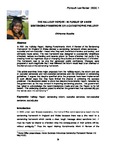The Halliday Report: In Pursuit of a New Sentencing Framework or a Catastrophic Failure?
| dc.contributor.author | Boothe, Chivonne | |
| dc.date.accessioned | 2017-03-27T15:44:46Z | |
| dc.date.accessioned | 2017-04-11T11:08:08Z | |
| dc.date.available | 2017-03-27T15:44:46Z | |
| dc.date.available | 2017-04-11T11:08:08Z | |
| dc.date.issued | 2008 | |
| dc.identifier.citation |
Boothe, C. (2008) 'The Halliday Report: In Pursuit of a New Sentencing Framework or a Catastrophic Failure?', Plymouth Law and Criminal Justice Review, 1, pp. 29-55. Available at: https://pearl.plymouth.ac.uk/handle/10026.1/8940 | en_US |
| dc.identifier.issn | 2054-149X | |
| dc.identifier.uri | http://hdl.handle.net/10026.1/8940 | |
| dc.description.abstract |
In 2001 the Halliday Report, Making Punishments Work: A Review of the Sentencing Framework for England & Wales devised a sentencing framework where sentences – custodial and non-custodial - meant what they said, benefited offenders and society, and ultimately made sense. The new framework was designed to successfully rehabilitate offenders, reduce re-offending and reserve prison for those offenders that justify it by creating novel but ingenious ways of changing the attitudes and behaviours of offenders. The framework was to be one that generated public confidence. Changes were proposed of such magnitude that it was believed the reform would lead to an overhaul of the dismal state of the sentencing framework. This article examines three major proposals from the Halliday report; the reform and use of custodial sentences and non-custodial sentences and the formulation of sentencing guidelines. It argues that despite specified aims the proposals have been implemented in such diluted ways that they have limited the chance of achieving the success predicted. The discussion seeks to show that despite the extensive Report, heralded by the government as the way forward in improving sentencing practice, the government has failed to acknowledge the recommendations made and use the Report to its full benefit. The underlying question posed is whether the government has successfully put the ‘sense back into sentencing’? | en_US |
| dc.language.iso | en | en_US |
| dc.publisher | University of Plymouth | |
| dc.rights | Attribution 4.0 International (CC BY 4.0) | * |
| dc.rights.uri | https://creativecommons.org/licenses/by/4.0/ | * |
| dc.subject | Halliday Report | en_US |
| dc.subject | sentencing reform | en_US |
| dc.subject | custodial sentence | en_US |
| dc.subject | non-custodial sentence | en_US |
| dc.subject | custody plus | en_US |
| dc.title | The Halliday Report: In Pursuit of a New Sentencing Framework or a Catastrophic Failure? | en_US |
| dc.type | Article | en_US |
| dc.type | Article | |
| plymouth.volume | 1 | |
| plymouth.journal | The Plymouth Law & Criminal Justice Review |



